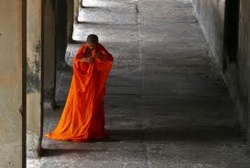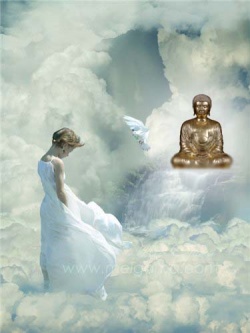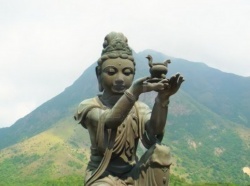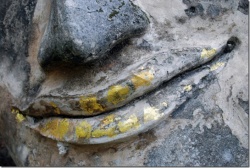Difference between revisions of "Meditation postures"
| Line 16: | Line 16: | ||
{{Wiki|lying}} down ([[sayana]], M.I,57). | {{Wiki|lying}} down ([[sayana]], M.I,57). | ||
</poem> | </poem> | ||
| + | |||
The significance of [[posture]] in [[Buddhism]] pertains mainly to the practise of [[meditation]]. | The significance of [[posture]] in [[Buddhism]] pertains mainly to the practise of [[meditation]]. | ||
During the preliminary [[stages of meditation]] the [[Buddha]] recommended (M.I,56) that one sit (nisidati), with the {{Wiki|legs}} crossed (pallankam) and the back straight (uju kayam). | During the preliminary [[stages of meditation]] the [[Buddha]] recommended (M.I,56) that one sit (nisidati), with the {{Wiki|legs}} crossed (pallankam) and the back straight (uju kayam). | ||
| + | |||
Most [[people]] find it helpful to put a pillow under their buttocks, place their hands either in their lap or on their knees and close their [[eyes]]. Some [[meditators]] might find it suits them better to sit on a chair rather than on the floor. | Most [[people]] find it helpful to put a pillow under their buttocks, place their hands either in their lap or on their knees and close their [[eyes]]. Some [[meditators]] might find it suits them better to sit on a chair rather than on the floor. | ||
| + | |||
| + | |||
The [[Visuddhimagga]] makes the helpful suggestion that [[meditators]] should try different [[postures]] for three days each and then decide on the one that is most comfortable for them (Vis.128). | The [[Visuddhimagga]] makes the helpful suggestion that [[meditators]] should try different [[postures]] for three days each and then decide on the one that is most comfortable for them (Vis.128). | ||
| + | |||
| + | |||
The two most important aspects of good [[meditation posture]] are | The two most important aspects of good [[meditation posture]] are | ||
| + | |||
(1) that the back be straight without being rigid so as to facilitate clear [[breathing]], and | (1) that the back be straight without being rigid so as to facilitate clear [[breathing]], and | ||
(2) that the [[body]] be [[relaxed]] and comfortable so that discomfort does not become a [[distraction]] (S.V,156). | (2) that the [[body]] be [[relaxed]] and comfortable so that discomfort does not become a [[distraction]] (S.V,156). | ||
| + | |||
Those whose goal is to develop [[mindfulness]], should do so with a regimen of regular sitting practise. However, after their [[mindfulness]] has been strengthened, it is necessary to then try to broaden it by becoming [[mindful]] during all [[activities]], i.e. while in any of the four [[postures]]. | Those whose goal is to develop [[mindfulness]], should do so with a regimen of regular sitting practise. However, after their [[mindfulness]] has been strengthened, it is necessary to then try to broaden it by becoming [[mindful]] during all [[activities]], i.e. while in any of the four [[postures]]. | ||
| + | |||
| + | |||
The [[Buddha]] said: "A [[monk]] has [[full awareness]] while coming and going, while reaching out his hands or drawing them back, while putting on his [[robes]] and carrying his [[bowl]], while eating and drinking, chewing and [[tasting]], even while defecating and urinating. | The [[Buddha]] said: "A [[monk]] has [[full awareness]] while coming and going, while reaching out his hands or drawing them back, while putting on his [[robes]] and carrying his [[bowl]], while eating and drinking, chewing and [[tasting]], even while defecating and urinating. | ||
| + | |||
| + | |||
He has [[full awareness]] while walking, [[standing]] and sitting, while falling to [[sleep]] and waking up, while talking and remaining [[silent]]" (M.I,57). | He has [[full awareness]] while walking, [[standing]] and sitting, while falling to [[sleep]] and waking up, while talking and remaining [[silent]]" (M.I,57). | ||
| + | |||
| + | |||
Choose a [[posture]] that is comfortable to sit in for 45 minutes to an hour. Do not force yourself to sit in one of the [[lotus]] [[postures]] if it is too [[painful]]. | Choose a [[posture]] that is comfortable to sit in for 45 minutes to an hour. Do not force yourself to sit in one of the [[lotus]] [[postures]] if it is too [[painful]]. | ||
| + | |||
| + | |||
“If [[pain]] was our goal we would be sitting on a bed of [[nails]].” (S.N. [[Goenka]] quoted in Hart) | “If [[pain]] was our goal we would be sitting on a bed of [[nails]].” (S.N. [[Goenka]] quoted in Hart) | ||
| + | |||
| + | |||
[[Pain]] is one of the meditator’s chief [[obstacles]], so don’t encourage it. | [[Pain]] is one of the meditator’s chief [[obstacles]], so don’t encourage it. | ||
| + | |||
| + | |||
Acceptable [[postures]] include full, half, and quarter [[lotus]], [[American]] [[Indian]], [[Burmese]], kneeling, or in a chair. | Acceptable [[postures]] include full, half, and quarter [[lotus]], [[American]] [[Indian]], [[Burmese]], kneeling, or in a chair. | ||
| + | |||
| + | |||
The goal of practice is to obtain [[mindfulness]] / [[awareness]] / [[equanimity]] during everyday [[life]], 24 hours a day, every day. | The goal of practice is to obtain [[mindfulness]] / [[awareness]] / [[equanimity]] during everyday [[life]], 24 hours a day, every day. | ||
| + | |||
| + | |||
Thus, eventually there will be [[mindfulness]] / [[awareness]] / [[equanimity]] even when we are not sitting, when we are working, eating, walking, etc. Therefore, [[clinging]] to a particular [[posture]] as the “one and only right way” is not necessary. | Thus, eventually there will be [[mindfulness]] / [[awareness]] / [[equanimity]] even when we are not sitting, when we are working, eating, walking, etc. Therefore, [[clinging]] to a particular [[posture]] as the “one and only right way” is not necessary. | ||
| + | |||
| + | |||
Full [[lotus]] is done by placing one foot on the thigh of the other leg and then the other foot is also placed on the thigh of the other leg. | Full [[lotus]] is done by placing one foot on the thigh of the other leg and then the other foot is also placed on the thigh of the other leg. | ||
| + | |||
| + | |||
Half [[lotus]] is when one foot is on the thigh of the other leg and the other foot is tucked in below the other leg (not on the thigh). | Half [[lotus]] is when one foot is on the thigh of the other leg and the other foot is tucked in below the other leg (not on the thigh). | ||
| + | |||
Quarter louts is when one foot is on the calf of the other leg. [[Burmese]] [[posture]] is when the {{Wiki|legs}} are crossed, but not tucked in under each other and the {{Wiki|legs}} are parallel to each other in front of you. | Quarter louts is when one foot is on the calf of the other leg. [[Burmese]] [[posture]] is when the {{Wiki|legs}} are crossed, but not tucked in under each other and the {{Wiki|legs}} are parallel to each other in front of you. | ||
| + | |||
| + | |||
[[Lotus]] [[postures]] were common well before the time of the [[Buddha]] and require increased [[flexibility]] and provide good [[balance]] during [[meditation]], but are in no way required to do [[Buddhist meditation]]. | [[Lotus]] [[postures]] were common well before the time of the [[Buddha]] and require increased [[flexibility]] and provide good [[balance]] during [[meditation]], but are in no way required to do [[Buddhist meditation]]. | ||
| + | |||
| + | |||
In [[Theravada]] (includes [[Vipassana]]) [[meditation]], the [[eyes]] are closed. | In [[Theravada]] (includes [[Vipassana]]) [[meditation]], the [[eyes]] are closed. | ||
| + | |||
This helps to center our [[awareness]] and [[attention]] inward. But if you need to open your [[eyes]] to [[feel]] more centered, this is okay too. | This helps to center our [[awareness]] and [[attention]] inward. But if you need to open your [[eyes]] to [[feel]] more centered, this is okay too. | ||
| + | |||
| + | |||
It is not uncommon to sometimes [[feel]] that you are falling or leaning one way or the other and the simple {{Wiki|solution}} is to open your [[eyes]] slightly until the [[feeling]] dissipates. | It is not uncommon to sometimes [[feel]] that you are falling or leaning one way or the other and the simple {{Wiki|solution}} is to open your [[eyes]] slightly until the [[feeling]] dissipates. | ||
| + | |||
| + | |||
While the [[eyes]] are open it is best to have a [[relaxed]] gaze about 2 meters (6 to 7 feet) in front of you toward the floor and your [[eyes]] are [[relaxed]] and not straining. | While the [[eyes]] are open it is best to have a [[relaxed]] gaze about 2 meters (6 to 7 feet) in front of you toward the floor and your [[eyes]] are [[relaxed]] and not straining. | ||
| + | |||
| + | |||
Virtually any type of clothing is acceptable, but most prefer flexible clothing for the cross-legged positions. | Virtually any type of clothing is acceptable, but most prefer flexible clothing for the cross-legged positions. | ||
| + | |||
| + | |||
[[Theravada Buddhists]] do not wear [[robes]] during [[meditation]] sessions and can wear whatever they like. See: [[Clothes & fashion]] and [[Buddhist fashion]] | [[Theravada Buddhists]] do not wear [[robes]] during [[meditation]] sessions and can wear whatever they like. See: [[Clothes & fashion]] and [[Buddhist fashion]] | ||
| + | |||
| + | |||
You may place your hands in your lap or wherever is comfortable. | You may place your hands in your lap or wherever is comfortable. | ||
The point is to be [[relaxed]] and not in a tense position with the {{Wiki|legs}}, hands, or the [[body]]. | The point is to be [[relaxed]] and not in a tense position with the {{Wiki|legs}}, hands, or the [[body]]. | ||
| + | |||
| + | |||
A common placement of hands that is popular is to put your right hand, palm up, under your left hand, palm up, and have the thumbs lightly [[touching]] each other. | A common placement of hands that is popular is to put your right hand, palm up, under your left hand, palm up, and have the thumbs lightly [[touching]] each other. | ||
| + | |||
Don’t struggle with [[pain]] when it arises in the {{Wiki|legs}}. | Don’t struggle with [[pain]] when it arises in the {{Wiki|legs}}. | ||
| Line 82: | Line 129: | ||
It is okay to change your [[posture]] in the [[meditation]] hall during the sitting, just mindfully note the change in [[posture]] and then make the change in your [[body]] position. | It is okay to change your [[posture]] in the [[meditation]] hall during the sitting, just mindfully note the change in [[posture]] and then make the change in your [[body]] position. | ||
| + | |||
| + | |||
| + | |||
{{R}} | {{R}} | ||
http://www.dhammawiki.com/index.php?title=Meditation_postures | http://www.dhammawiki.com/index.php?title=Meditation_postures | ||
[[Category:Meditation]] | [[Category:Meditation]] | ||
[[Category:Asanas]] | [[Category:Asanas]] | ||
| + | [[Category:Buddhist Terms]] | ||
| + | [[Category:Buddhism]] | ||
Latest revision as of 14:23, 1 December 2023
A posture (iriyapatha) is a position the body is held in.
The Buddhist scriptures frequently speak of four postures –
The significance of posture in Buddhism pertains mainly to the practise of meditation.
During the preliminary stages of meditation the Buddha recommended (M.I,56) that one sit (nisidati), with the legs crossed (pallankam) and the back straight (uju kayam).
Most people find it helpful to put a pillow under their buttocks, place their hands either in their lap or on their knees and close their eyes. Some meditators might find it suits them better to sit on a chair rather than on the floor.
The Visuddhimagga makes the helpful suggestion that meditators should try different postures for three days each and then decide on the one that is most comfortable for them (Vis.128).
The two most important aspects of good meditation posture are
(1) that the back be straight without being rigid so as to facilitate clear breathing, and
(2) that the body be relaxed and comfortable so that discomfort does not become a distraction (S.V,156).
Those whose goal is to develop mindfulness, should do so with a regimen of regular sitting practise. However, after their mindfulness has been strengthened, it is necessary to then try to broaden it by becoming mindful during all activities, i.e. while in any of the four postures.
The Buddha said: "A monk has full awareness while coming and going, while reaching out his hands or drawing them back, while putting on his robes and carrying his bowl, while eating and drinking, chewing and tasting, even while defecating and urinating.
He has full awareness while walking, standing and sitting, while falling to sleep and waking up, while talking and remaining silent" (M.I,57).
Choose a posture that is comfortable to sit in for 45 minutes to an hour. Do not force yourself to sit in one of the lotus postures if it is too painful.
“If pain was our goal we would be sitting on a bed of nails.” (S.N. Goenka quoted in Hart)
Pain is one of the meditator’s chief obstacles, so don’t encourage it.
Acceptable postures include full, half, and quarter lotus, American Indian, Burmese, kneeling, or in a chair.
The goal of practice is to obtain mindfulness / awareness / equanimity during everyday life, 24 hours a day, every day.
Thus, eventually there will be mindfulness / awareness / equanimity even when we are not sitting, when we are working, eating, walking, etc. Therefore, clinging to a particular posture as the “one and only right way” is not necessary.
Full lotus is done by placing one foot on the thigh of the other leg and then the other foot is also placed on the thigh of the other leg.
Half lotus is when one foot is on the thigh of the other leg and the other foot is tucked in below the other leg (not on the thigh).
Quarter louts is when one foot is on the calf of the other leg. Burmese posture is when the legs are crossed, but not tucked in under each other and the legs are parallel to each other in front of you.
Lotus postures were common well before the time of the Buddha and require increased flexibility and provide good balance during meditation, but are in no way required to do Buddhist meditation.
In Theravada (includes Vipassana) meditation, the eyes are closed.
This helps to center our awareness and attention inward. But if you need to open your eyes to feel more centered, this is okay too.
It is not uncommon to sometimes feel that you are falling or leaning one way or the other and the simple solution is to open your eyes slightly until the feeling dissipates.
While the eyes are open it is best to have a relaxed gaze about 2 meters (6 to 7 feet) in front of you toward the floor and your eyes are relaxed and not straining.
Virtually any type of clothing is acceptable, but most prefer flexible clothing for the cross-legged positions.
Theravada Buddhists do not wear robes during meditation sessions and can wear whatever they like. See: Clothes & fashion and Buddhist fashion
You may place your hands in your lap or wherever is comfortable.
The point is to be relaxed and not in a tense position with the legs, hands, or the body.
A common placement of hands that is popular is to put your right hand, palm up, under your left hand, palm up, and have the thumbs lightly touching each other.
Don’t struggle with pain when it arises in the legs.
Observe the pain and do not put any resistance to it.
If the pain is still too strong, change your posture.
It is okay to change your posture in the meditation hall during the sitting, just mindfully note the change in posture and then make the change in your body position.
Source
http://www.dhammawiki.com/index.php?title=Meditation_postures



